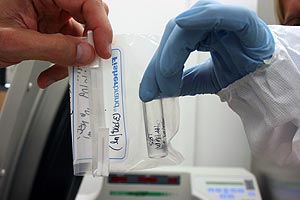This story marks the first time I've had to use a pseudynm to protect the identity of a horse.
"Disney's" owner's desire for privacy only underscores the stakes here. Performance horses at his level can be worth $60,000 and more. Training, too, is an enormous investment. "Gretchen," as we call her in the piece, has spent years training Disney in English dressage (which, incidentally, makes for some very entertaining YouTube viewing if you have some time to kill). And so when she noticed that her horse's gait had started to suffer, she jumped to find a treatment.
Speed is key here, it was explained to me, because the smaller the injury, the better a horse's chance for recovery. Emphasizing that point is one of the main reasons Gretchen agreed to take part in this program. She says too many owners treat their horses' injuries with ever-greater doses of painkillers, delaying real treatment until it's too late. Gretchen estimated that, including all the preliminary visits and tests, Disney's treatment may reach $7,000.
Davis vets couldn't provide statistics on whether this treatment - injecting a horse's mesenchymal stem cells, drawn from the marrow of the animal's sternum, into the same animal's torn tendon - succeeds in producing new tendon tissue. (Part of the problem is that it's hard to distinguish tendon tissue from scar tissue, seen through an ultrasound.) But if it works, they believe humans may one day have another option for treating our torn ligaments, too.

